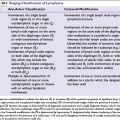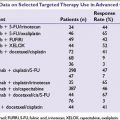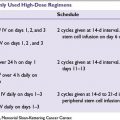INDICATIONS
ASCO and ASH Guidelines
In nonmyeloid cancers, ESAs should be considered as one of the many options in patients receiving chemotherapy whose anemia is symptomatic and chemotherapy related. The goals are avoidance of blood transfusions and possible symptomatic benefit. ESAs can be initiated if Hb falls below 10. For Hb levels between 10 and 12, use of ESAs should only be based on symptoms, clinical circumstances, and patient preference. If there is no response after 6 to 8 weeks with appropriate dose modification, treatment should be discontinued. Blood transfusion is a therapeutic option.
FDA-Approved Indications
ESAs are approved for chemotherapy-related anemia in nonmyeloid malignancies treated with palliative intent, CRF, HIV (zidovudine) therapy, and to reduce the need for blood transfusion in elective noncardiac and nonvascular surgeries.
Off-Label/Investigational Use
■There is evidence supporting the use of ESAs for anemia related to MDS. However, patients may require higher doses and response may be delayed. Predictors of response include low-risk MDS and low EPO levels (≤200 units/L). Combining ESAs and G-CSF in MDS patients has resulted in improved response rates.
■Other reported uses include multiple myeloma, non-Hodgkin lymphoma, chronic lymphocytic leukemia, β-thalassemia, radiation therapy, rheumatoid arthritis, paroxysmal nocturnal hemoglobulinuria, Castleman disease, congestive heart failure, critical illnesses, hepatitis C (in patients treated with interferon-α and ribarvirin), and blood-unit collection for autotransfusion.
DOSING
Recommended dosing and dose adjustments of ESAs in chemotherapy-induced anemia are listed in Table 34.1. After initiation or dose modification of ESAs, Hb should be monitored weekly until it stabilizes.
SIDE EFFECTS
■The most serious side effects of ESAs are thromboembolic events, defined as transient ischemic attack, stroke, pulmonary emboli, deep vein thrombosis, and myocardial infarction. A meta-analysis showed that thromboembolic events increased 67% in cancer patients; for a population with baseline risk of 20%, the number needed to harm would be 7.5 patients (95% CI 3.1 to 15.6). There is evidence for increased risk of thromboembolic events in CRF and surgical patients, especially with higher Hb targets. Preliminary analysis of a trial in spinal surgery patients given ESAs to decrease postsurgery transfusion requirements showed increased incidence of thromboembolic events in the ESA arm. Notably, patients received no prophylactic anticoagulants postoperatively.
■ESAs are contraindicated in uncontrolled hypertension, more commonly seen in CRF patients who receive IV ESAs.
■Other side effects include headache, fatigue, fever, rash, pruritis, hypersensitivity reactions, arthralgia and myalgia, nausea, seizures, and pure red-cell aplasia due to neutralizing antibodies to native EPO.
OTHER CONSIDERATIONS
■Iron supplementation should be considered in patients receiving ESAs, especially those with borderline iron stores, because iron deficiency can develop soon after initiation of ESAs and can adversely affect response to ESAs. Data from multiple controlled trials have shown that IV iron can enhance ESA efficacy and can reduce the required dose in cancer patients.
■Measuring serum EPO levels may help to identify patients more likely to respond to ESAs. Patients with baseline EPO levels ≤100 units/L are more likely to respond to ESAs than those with levels >100 units/L.
PLATELET GROWTH FACTORS
■Thrombocytopenia can be a life-threatening consequence of antineoplastic treatments. Platelet transfusions are required to prevent or mitigate hemorrhagic complications. Patients at high risk for bleeding or who experience delays in receiving planned chemotherapy include the following:
•Patients with poor bone marrow reserve or a history of bleeding
•Patients on treatment regimens highly toxic to bone marrow
•Patients with a potential bleeding site (e.g., necrotic tumor)
■Fortunately, iatrogenic thrombocytopenia that requires platelet transfusion or causes major bleeding is relatively uncommon, although occurrence tends to increase with cumulative cycles of chemotherapy that are toxic to hematopoietic progenitor cells. At present, formal guidelines for the use of thrombopoietic growth factors are under development.
■
Stay updated, free articles. Join our Telegram channel

Full access? Get Clinical Tree






